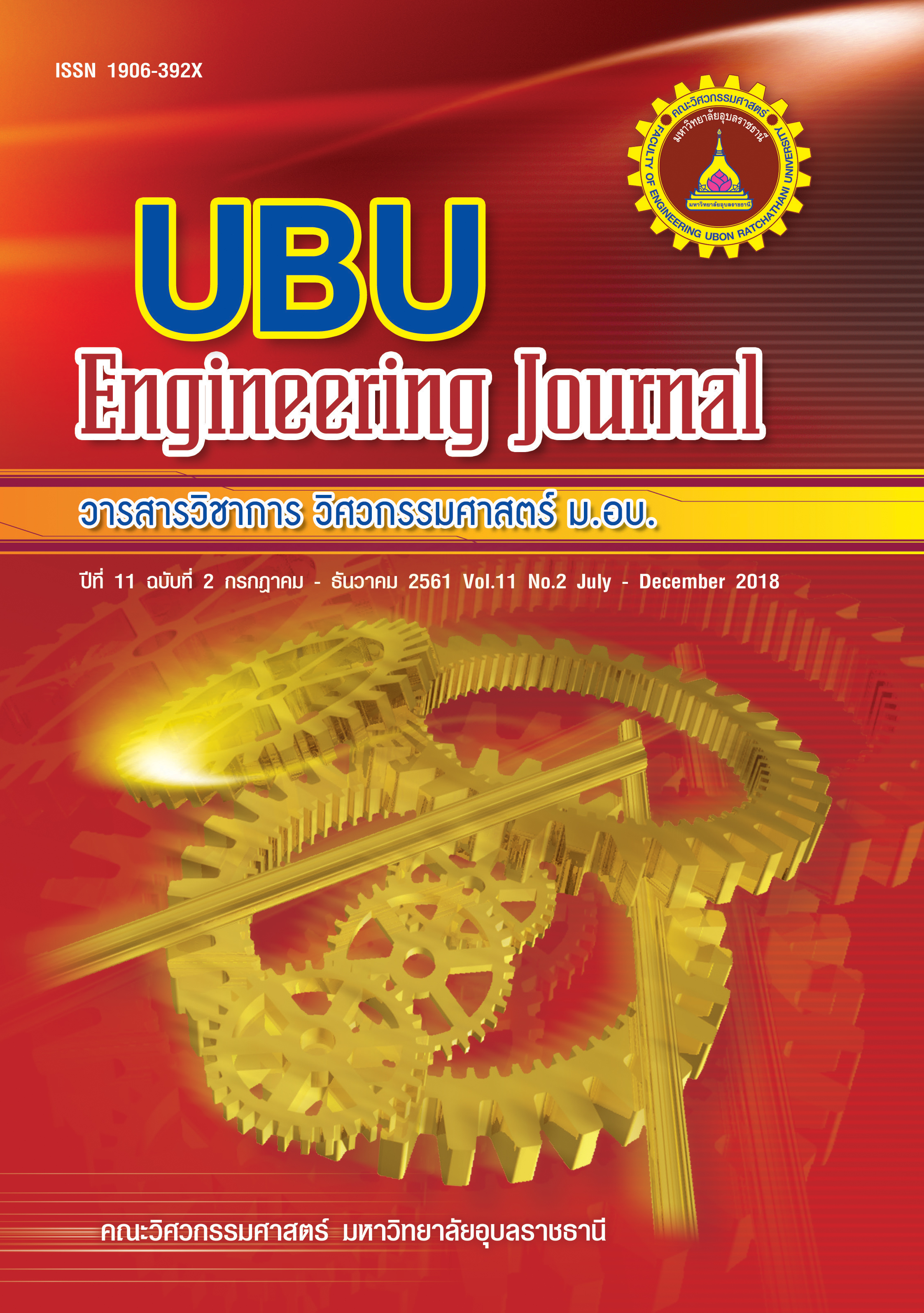กำลังอัดและโครงสร้างจุลภาคของดินลูกรัง-กากกาแฟปรับปรุงด้วยเถ้าลอยจีโอโพลีเมอร์
Main Article Content
บทคัดย่อ
บทความนี้ศึกษากำลังอัดและโครงสร้างจุลภาคของดินลูกรัง-กากกาแฟปรับปรุงด้วยเถ้าลอย จีโอโพลีเมอร์ เถ้าลอยนำมาจากโรงงานผลิตกระแสไฟฟ้าแม่เมาะ จังหวัดลำปาง กากกาแฟได้จากร้านกาแฟในพื้นที่ จังหวัดนครราชสีมา สารกระตุ้นเป็นส่วนผสมของสารละลายโซเดียมซิลิเกต (Na2SiO3) และโซเดียมไฮดรอกไซด์ (NaOH) อัตราส่วน Na2SiO3:NaOH เท่ากับ 50:50 ความเข้มข้น (NaOH) เท่ากับ 5 โมลาร์ ทดสอบกำลังอัดของตัวอย่างที่อายุบ่ม 7 วัน ผลการทดสอบแสดงให้เห็นว่าหน่วยน้ำหนักแห้งสูงสุดมีค่าลดลงตามการเพิ่มขึ้นของปริมาณกากกาแฟ โดยที่หน่วยน้ำหนักแห้งสูงสุดของตัวอย่างมีค่าเท่ากับ 20.12 19.75 18.96 และ18.05 kN/m3 สำหรับปริมาณกากกาแฟเท่ากับร้อยละ 0 10 20 และ 30 โดยน้ำหนัก ตามลำดับ หน่วยน้ำหนักลดลงเกิดจากอนุภาคของกากกาแฟที่มีความพรุนสูง กำลังอัดของดินลูกรัง-กากกาแฟปรับปรุงด้วยเถ้าลอย จีโอโพลีเมอร์ที่อายุบ่ม 7 วัน และปริมาณความชื้นเหมาะสมให้กำลังอัดสูงสุดซึ่งมีค่าเท่ากับ 2.57 1.82 1.40 และ 0.88 MPa สำหรับปริมาณกากกาแฟเท่ากับร้อยละ 0 10 20 และ 30 ตามลำดับ
Article Details
References
energy. J. Agric. Food Chem. 2008; 56: 11757– 11760.
[2] Boonamnuayvitaya V, Chaiya C, Tanthapanichakoon W, Jarudilokkul S. Removal of heavy metals by adsorbent prepared from pyrolyzed coffee residues and clay. Separation and Purification Technology. 2004; 35: 11–22.
[3] Suksiripattanapong C, Horpibulsuk S, Chanprasert P. Sukmak P, Arulrajah A. Compressive strength development in fly ash geopolymer masonsy units manufactured from water treatment sludge. Construction and Building Materials. 2015; 82: 20–30.
[4] Horpibulsuk S, Suksiripattanapong C, Samingthong W, Chinkulkijniwat A, Rachan R, Arulrajah A. Durability against wet-dry cycles of water treatment sludge–fly ash geopolymer. Journal of Materials in Civil Engineering. 2015; 94: 807–816.
[5] Suksiripattanapong C, Horpibulsuk S, Boongrasan S. Udomchai A, Chinkulkijniwat A, Arulrajah A. Unit weight, strength and microstructure of a water treatment sludge–fly ash lightweight cellular geopolymer. Construction and Building Materials. 2015; 58: 254–257. [6] Suksiripattanapong C, Srijumpa S, Horpibulsuk S, Sukmak P, Arulrajah A, Du JY. Compressive strength of water treatment sludge–fly ash geopolymer at various compression energies. Lowland Technology International Journal. 2015; 17(2).
[7] Sukmak P, Horpibulsuk S, Shen SL. Strength development in clay–fly ash geopolymer. Construction and Building Materials. 2013; 40: 566–574.
[8] Sukmak P, Horpibulsuk S, Shen SL, Chindaprasirt P, Suksiripattanpong C. Factors influencing strength development in clay-fly ash geopolymer. Construction and Building Materials. 2013; 47: 1125–1135.
[9] Kua TA, Arulrajah A, Horpibulsuk S, Shen SL, Du YJ. Strength assessment of spent coffee groundsgeopolymer cement utilizing slag and fly ash precursors. Construction and Building Materials. 2016; 115: 565–575.
[10] Kua TA, Arulrajah A, Horpibulsuk S, Du YJ, Suksiripattanapong C. Engineering and environmental evaluation of spent coffee grounds stabilized with industrial by-products as a road subgrade material. Clean technologies and environmental policy. 2017; 19: 63–75.
